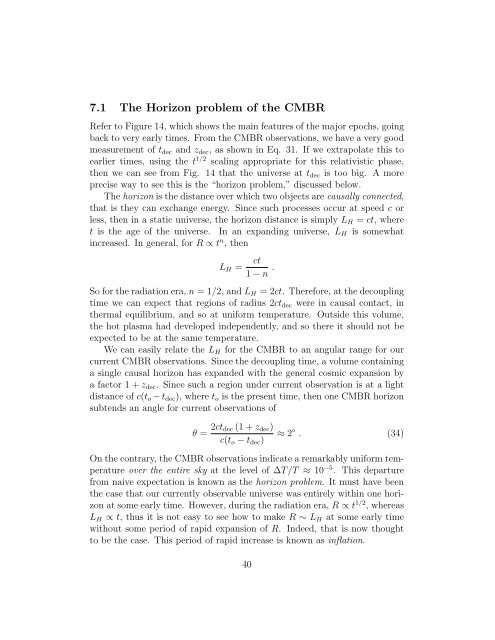Lecture Notes for Astronomy 321, W 2004 1 Stellar Energy ...
Lecture Notes for Astronomy 321, W 2004 1 Stellar Energy ...
Lecture Notes for Astronomy 321, W 2004 1 Stellar Energy ...
You also want an ePaper? Increase the reach of your titles
YUMPU automatically turns print PDFs into web optimized ePapers that Google loves.
7.1 The Horizon problem of the CMBR<br />
Refer to Figure 14, which shows the main features of the major epochs, going<br />
back to very early times. From the CMBR observations, we have a very good<br />
measurement of t dec and z dec , as shown in Eq. 31. If we extrapolate this to<br />
earlier times, using the t 1/2 scaling appropriate <strong>for</strong> this relativistic phase,<br />
then we can see from Fig. 14 that the universe at t dec is too big. A more<br />
precise way to see this is the “horizon problem,” discussed below.<br />
The horizon is the distance over which two objects are causally connected,<br />
that is they can exchange energy. Since such processes occur at speed c or<br />
less, then in a static universe, the horizon distance is simply L H = ct, where<br />
t is the age of the universe. In an expanding universe, L H is somewhat<br />
increased. In general, <strong>for</strong> R ∝ t n , then<br />
L H =<br />
ct<br />
1 − n .<br />
So <strong>for</strong> the radiation era, n = 1/2, and L H = 2ct. There<strong>for</strong>e, at the decoupling<br />
time we can expect that regions of radius 2ct dec were in causal contact, in<br />
thermal equilibrium, and so at uni<strong>for</strong>m temperature. Outside this volume,<br />
the hot plasma had developed independently, and so there it should not be<br />
expected to be at the same temperature.<br />
We can easily relate the L H <strong>for</strong> the CMBR to an angular range <strong>for</strong> our<br />
current CMBR observations. Since the decoupling time, a volume containing<br />
a single causal horizon has expanded with the general cosmic expansion by<br />
a factor 1 + z dec . Since such a region under current observation is at a light<br />
distance of c(t o − t dec ), where t o is the present time, then one CMBR horizon<br />
subtends an angle <strong>for</strong> current observations of<br />
θ = 2ct dec (1 + z dec )<br />
c(t o − t dec )<br />
≈ 2 ◦ . (34)<br />
On the contrary, the CMBR observations indicate a remarkably uni<strong>for</strong>m temperature<br />
over the entire sky at the level of ∆T/T ≈ 10 −5 . This departure<br />
from naive expectation is known as the horizon problem. It must have been<br />
the case that our currently observable universe was entirely within one horizon<br />
at some early time. However, during the radiation era, R ∝ t 1/2 , whereas<br />
L H ∝ t, thus it is not easy to see how to make R ∼ L H at some early time<br />
without some period of rapid expansion of R. Indeed, that is now thought<br />
to be the case. This period of rapid increase is known as inflation.<br />
40













